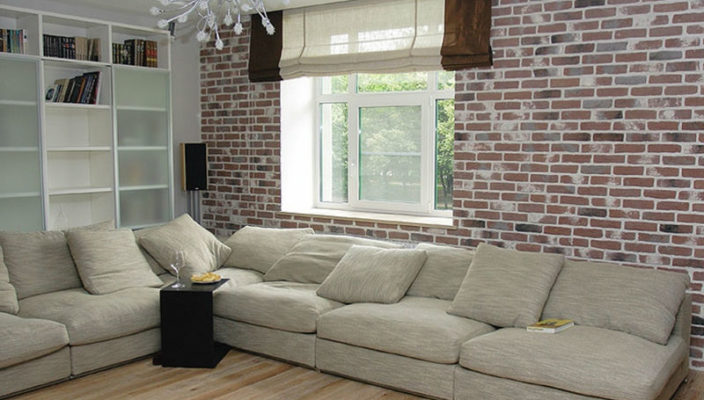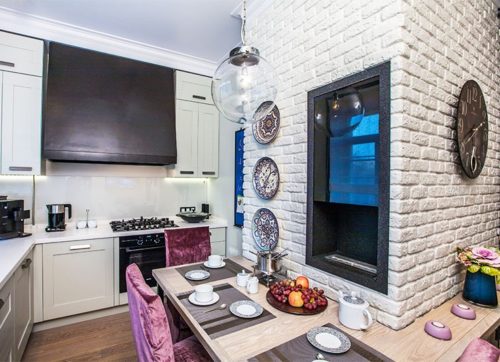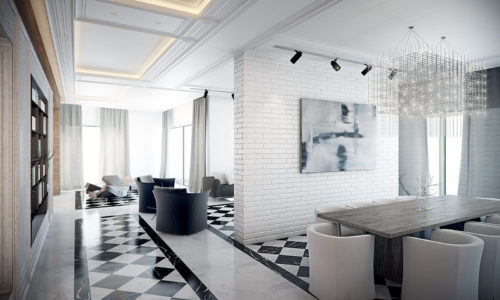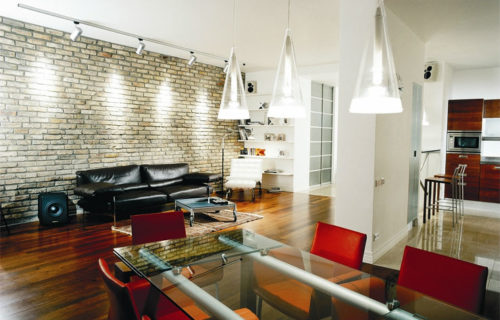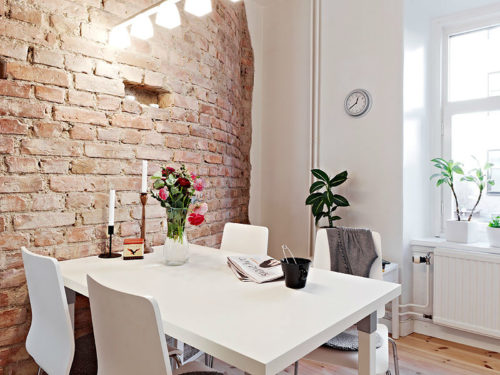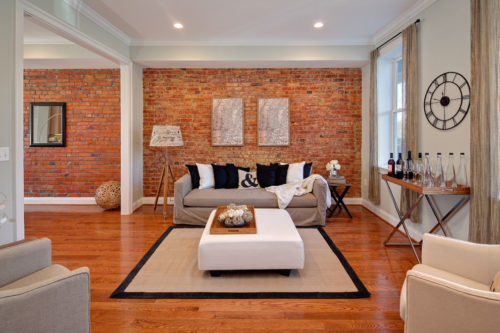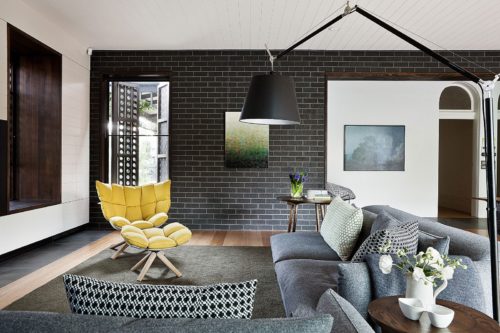Decorative brick in the interior is a relatively new, but very popular stylistic solution, often used in the directions of grunge, high-tech, loft and others. We will tell about the finishing of walls with decorative brick in this article.
Content
Types of decorative brick bricks for walls
Decorative brick for interior decoration is a few species, then we will focus more on each of them.
Artificial decorative brick on plaster basis
Make a brick from plaster can be even independently, if there are appropriate forms for filling the solution. Such material has many advantages:
- gypsum light weight is well transported and easily mounted;
- brick from it can have different shades and textures;
- the material is not terrible high temperatures;
- gypsum is environmentally friendly, vapor permanent, has good flexural strength and compression;
- with proper care, such a cladding exists for many years.
The disadvantages include:
- fragility;
- the ability to absorb moisture well, which narrows the scope of using such a finish.
But, since the gypsum brick is much cheaper than all its analogues, then in rooms with air humidity not higher than 65% it is used quite often.
Decorative ceramic brick
Ceramic brick is made of clay, into which sand and quartz crumb add. Mixed components formulate and burn, getting durable and solid material. Such decorative brick for the house has a number of benefits:
- in terms of its qualities, it is similar to clinker tiles, because it is often used in places with high humidity;
- ceramic brick tolerate cold, heating, temperature drops;
- wireless material and durable, and also very practical.
By cons of ceramic finishes include its high price. Use such a cladding in those places where humidity is increased or there are frequent temperatures. Such zones, for example, are fireplaces, chimneys, verandas and balconies. The life of ceramic brick is at least 30 years.
A separate type of such material is porcelain stoneware. It is made by pressing and burned in the furnace twice, and a stone crumb is added to the composition. Porcelain stoneware is considered one of the most expensive facing.
Decorative cement brick
Cement brick is made by analogy with plaster. Various fillers with thermal insulation characteristics are added to the cement solution for such a material, for example, crumbs of clay or perlite. In addition to them, the component composition includes dyes, as well as additives to increase strength. To give the material the best water-repellent properties, acrylic resins or polymer substances are sometimes added to it.
Decorative cement wall brick has the following advantages:
- it is durable and moisture-resistant;
- almost universal in use;
- serves many years.
By minuses include the following:
- high weight, complicating installation process;
- some polymer additives are unsafe for health.
Scope of use of decorative brick
Decorative brick is widely used in the interior decoration of the premises, and you can meet it in the design of any rooms: living rooms, kitchens, hallways, corridors, bedrooms. With the help of this material, you can select some special items and "highlights" of the interior, for example, mirrors, fireplace areas, window or doorways, various niches.
Apply brick and for zoning rooms. Wall decoration with decorative bricks can be found near the fountains, bar racks, on kitchen aprons. Sometimes the material is facing a separate angle of the room. Those who want to use a similar decor element, designers recommend the following:
- The brick finish in the interior must be in moderation, it is not worth overdoing with it. That is, to allocate in the room better some separate zones and plots, which, in your opinion, seem most beneficial. It can be part of a wall behind a TV or a sofa, near the dining table, etc.
- In modern interiors, an interesting method for combining materials of different colors is used. That is, one zone in the room can be implanted, for example, brick red shade, other - yellow.
- Decorative brick is successfully combined with textured plaster, expensive wallpaper, wood.
- The interior in which there are walls made of decorative bricks, must correspond to such a styling finish. Some interior styles do not accept coarse textures, and in some, on the contrary, it looks appropriate and harmonious.
- An ideal place for the use of brickwork is an entrance hall or corridor. Moreover, for such a room it is better to choose the material of dark shades, on which the contamination is not so visible. But there is here and the nuance: if the hallway is small or narrow, then decoration, on the contrary, it is better to pick up bright tones to at least visually add spaces.
- The color of the decorative brick matters for all other rooms at home. For example, a spacious living room is better to separate the material of the classic red shade with the simulation of old masonry, but in a small room, as in a small hallway, more relevant will be white or light gray brick.
- The most often brick finish can be found in fireplace areas, where there is not only the hearth itself, but also the wall behind it and the podium. With the help of live plants and appropriate textile accessories, you can browse in the interior of the styles of the style. In combination with a modern furniture headcard, almost the absence of decor, the interior will become minimalist.
- In the kitchen, decorative brick can be used in various zones. Most popular options: kitchen apron, wall near the dining table. If there is a TV in the kitchen, you can select a brick masonry zone behind it.
Decorative Brick: Colors and Styles
Decorative brickwork can be performed in various shades:
- The traditional option is a material of reddish-brown. As a rule, it is best for this design looks in restrained interiors and in limited quantities. Even a small area in the room, decorated in a similar way, will help create a special atmosphere.
- White decorative brick is although not considered a classic, but not in popularity is not inferior to the red. It can be used in the interior not so dosed, because the light shade does not overload the space. In addition, the white finish attracts attention, so it can be distinguished by the most significant and winning details of the room. It is worth noting that the bright brickwork is combined with almost any atmosphere and furniture.
- In modern interiors, designers use the original reception of the resulting brickwork. To implement such an idea, you can buy ready-made, artificially aged material, and you can make it one on your own. For this purpose, as a rule, the wall is treated with acid, emery paper or burn with a solder lamp.
There are certain interior styles in which the brick finish looks harmonious and naturally:
- Industrial style and Loft style - this is where such a design can be found most often. It is a brick that gives the interior special industrial aesthetics. And to emphasize it even more favorably, use furniture with metal elements, decorate the ceiling with rude beams or pipes.
- Apply brickwork and in country style. Such material often distinguishes the scenario zone or make accents on some kitchen walls. The brick adds a special charm of a rural dwelling, brings the atmosphere of comfort and naturalness.
- Decorative brick is found in interior styles like Gothic and Neoetics. They are associated with old castles and knightly times. The masonry in such premises is performed on the walls and columns. In such cases, the brick is successfully combined with luxurious, exquisite furniture.
- Modern interior style, although it is considered the opposite of country, also involves the use of decoration in the form of decorative bricks. As a rule, such material is combined with black, gray or white trim.
Decorative Brick Installation Tips
If you disassemble the laying of decorative bricks in stages, then these main steps can be distinguished:
- Measurement of the area allocated for lining, the subsequent calculation of the material. The figures obtained as a result of this calculation should be added another 10-12%.
- Preparatory work, which include the leveling of the working surface, coating its primer. The primer base is needed to provide good adhesion of materials, as well as to protect cladding from mold and fungus.
- Next stage - applying markings and installation of auxiliary parts: strips and crosses.
- Next, it is directly installation of a brick.
- After pouring the solution, the scum is made and the joints of the seams, their washing.
- The last stage is the coating of the finished surface with protective impregnations or varnishes. This action is not mandatory, but recommended.
As for the installation of decorative brick, you can give a few useful recommendations:
- The preparation of the working foundation should be carried out carefully and responsibly. The wall on which the brick will be mounted should be smooth and solid, do not shrink, do not have contamination and fat spots. The working surface is checked by the level, eliminate all the shortcomings, are equalized in a convenient way, for example, plastering or separated by thick plasterboard. Brick is a heavy material, and with incorrectly conducted preparatory work, he can simply fall off from the wall. Some specialists even recommend first to make a trial attempt and cover a small site, and then leave it for 3-4 days.
- When installing, the angular and framing details are first laid.
- Surface markup is the mandatory step on which the entire final result depends.
- The corners are best framed by rustic stone or specially intended angular elements that look neat and smoothly. If there is no rustic stone, the bricks on the corners are mounted on either cutting the contacting faces at an angle of 45 °.
- The direction in which you will move depends on the type of seams. If the material is embedded, it is better to start the process from below, if between the elements of the seams will be extended, then the installation option is more appropriate. When laying an online jack, thus, the brick will not slide down, with the same solution, the material will not be stained.
- If the brick is heavy and has a thickness of more than 1.5 cm, then every 3rd row needs to take a break. Starting further work, the laid coating must be checked.
- It is desirable to have elements with a displacement, as with standard brickwork. True, in this case there is no need to abide by some certain norms, on the contrary, such a decorative finish makes it possible to fantasize and implement creative ideas. In one masonry, it is possible to use elements that differ in thickness, texture and shade.
- The last stage is putting seams. It is produced when the glue is completely dry, fortunately, many modern compositions are frozen after the day after installation. The rapid solution is applied by a pistol or a finger, after removing all the auxiliary elements and excess glue from the surface. The grout color may correspond to a brick shade or be contrasting, it all depends on personal preferences and flavors.

